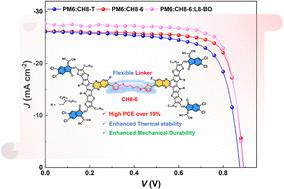当前位置:
X-MOL 学术
›
Energy Environ. Sci.
›
论文详情
Our official English website, www.x-mol.net, welcomes your feedback! (Note: you will need to create a separate account there.)
Rational design of flexible-linked 3D dimeric acceptors for stable organic solar cells demonstrating 19.2% efficiency
Energy & Environmental Science ( IF 32.4 ) Pub Date : 2024-06-28 , DOI: 10.1039/d4ee01943a Zhe Zhang 1 , Shaohui Yuan 2 , Tianqi Chen 2 , Jia Wang 2 , Yuan-Qiu-Qiang Yi 3 , Bin Zhao 4 , Miaomiao Li 4 , Zhaoyang Yao 1 , Chenxi Li 1 , Xiangjian Wan 1 , Guankui Long 2 , Bin Kan 2 , Yongsheng Chen 1
Energy & Environmental Science ( IF 32.4 ) Pub Date : 2024-06-28 , DOI: 10.1039/d4ee01943a Zhe Zhang 1 , Shaohui Yuan 2 , Tianqi Chen 2 , Jia Wang 2 , Yuan-Qiu-Qiang Yi 3 , Bin Zhao 4 , Miaomiao Li 4 , Zhaoyang Yao 1 , Chenxi Li 1 , Xiangjian Wan 1 , Guankui Long 2 , Bin Kan 2 , Yongsheng Chen 1
Affiliation

|
Despite substantial improvements in the power conversion efficiencies (PCEs) of organic solar cells (OSCs), achieving long-term stability still presents a formidable challenge to their commercial viability. Inspired by the efficient and stable 3D dimeric acceptors of the CH8 series, we developed two dimeric acceptors, CH8-6 and CH8-7, by linking two monomers with flexible alkyl linkers. Interestingly, both the monomeric acceptor CH8-T and dimeric acceptor CH8-6 exhibited similar optical and electronic properties, including molecular absorption, energy levels, packing, and crystallinity, indicating that the incorporated linkers exerted minimal influence on the molecular properties. Such linkers could facilitate morphological optimization, enabling CH8-6- and CH8-7-based binary OSCs to achieve a better PCE than their corresponding mono-like molecules. Furthermore, adding L8-BO to the binary OSCs facilitated appropriate phase separation and order packing, allowing PM6:CH8-6:L8-BO ternary OSCs to achieve a record-high PCE of 19.2% for oligomeric acceptors. Moreover, incorporating a flexible linker suppressed molecular diffusion, stabilizing the active-layer morphology. Consequently, PM6:CH8-6 binary OSCs exhibited excellent thermal stability, while PM6:CH8-6 flexible OSCs also demonstrated remarkable mechanical flexibility, maintaining 96% of their initial PCE even after 1200 bending cycles. Therefore, this study presents a feasible approach to improve the PCE, stability, and flexibility of OSCs simultaneously.
中文翻译:

用于稳定有机太阳能电池的柔性连接 3D 二聚体受体的合理设计显示出 19.2% 的效率
尽管有机太阳能电池(OSC)的功率转换效率(PCE)有了显着提高,但实现长期稳定性仍然对其商业可行性提出了巨大的挑战。受CH8系列高效稳定的3D二聚体受体的启发,我们通过使用柔性烷基连接体连接两个单体,开发了两种二聚体受体CH8-6和CH8-7。有趣的是,单体受体CH8-T和二聚体受体CH8-6都表现出相似的光学和电子特性,包括分子吸收、能级、堆积和结晶度,表明掺入的连接体对分子特性的影响最小。这种接头可以促进形态优化,使基于 CH8-6 和 CH8-7 的二元 OSC 能够比相应的单类分子获得更好的 PCE。此外,将L8-BO添加到二元OSC中促进了适当的相分离和有序堆积,使得PM6:CH8-6:L8-BO三元OSC能够实现低聚受体的19.2%的创纪录高PCE。此外,加入柔性连接体抑制了分子扩散,稳定了活性层的形态。因此,PM6:CH8-6二元OSC表现出优异的热稳定性,而PM6:CH8-6柔性OSC也表现出卓越的机械灵活性,即使在1200次弯曲循环后仍能保持96%的初始PCE。因此,本研究提出了一种同时提高 OSC 的 PCE、稳定性和灵活性的可行方法。
更新日期:2024-06-28
中文翻译:

用于稳定有机太阳能电池的柔性连接 3D 二聚体受体的合理设计显示出 19.2% 的效率
尽管有机太阳能电池(OSC)的功率转换效率(PCE)有了显着提高,但实现长期稳定性仍然对其商业可行性提出了巨大的挑战。受CH8系列高效稳定的3D二聚体受体的启发,我们通过使用柔性烷基连接体连接两个单体,开发了两种二聚体受体CH8-6和CH8-7。有趣的是,单体受体CH8-T和二聚体受体CH8-6都表现出相似的光学和电子特性,包括分子吸收、能级、堆积和结晶度,表明掺入的连接体对分子特性的影响最小。这种接头可以促进形态优化,使基于 CH8-6 和 CH8-7 的二元 OSC 能够比相应的单类分子获得更好的 PCE。此外,将L8-BO添加到二元OSC中促进了适当的相分离和有序堆积,使得PM6:CH8-6:L8-BO三元OSC能够实现低聚受体的19.2%的创纪录高PCE。此外,加入柔性连接体抑制了分子扩散,稳定了活性层的形态。因此,PM6:CH8-6二元OSC表现出优异的热稳定性,而PM6:CH8-6柔性OSC也表现出卓越的机械灵活性,即使在1200次弯曲循环后仍能保持96%的初始PCE。因此,本研究提出了一种同时提高 OSC 的 PCE、稳定性和灵活性的可行方法。











































 京公网安备 11010802027423号
京公网安备 11010802027423号